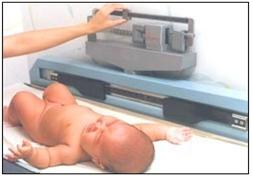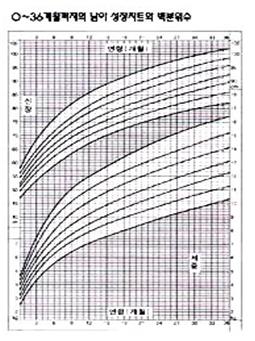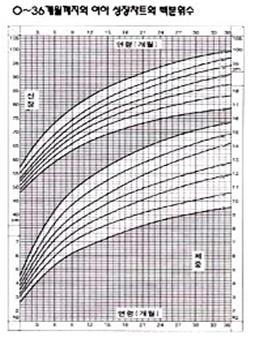신생아들, 영아들, 타들러 유아들, 학령기 전 유아들, 학령기아들, 사춘기아들의 체중 증가, Weight gaining of infants, toddlers, preschoolers, school children and adolescents
- 생후 1∼2주에서 5개월까지 신생들이나 영아들은 1일 평균 15∼20g 체중이 증가된다.
- 생후 5개월 이후부터 돌이 될 때까지 영아들의 체중은 1일 평균 10∼15g 정도 증가된다.
- 생후 4∼5개월 때 영아들의 체중은 출생 시 체중의 2배 정도 되고 생후 1세 아기의 체중은 출생 시 체중의 3배 정도 증가된다.
- 위에서 설명한 1일 평균 체중 증가치는 미국 신생아들의 성장 통계에서 얻은 정보이다.
- 갓 태어난 신생아의 체중치와 신장치가 갓 태어난 신생아의 성장차트의 체중 백분위선과 신장 백분위선의 어디에 있는지 알아본다.
- 아기의 체중과 신장이 몇 백분위선에 속하는지 즉 몇 퍼센타일(Percentile)에 속하는지 알아본다. 참고로, “소아가정간호백과”편에 있는 성장 차트는 저자가 한국 소아들의 체중과 신장치를 기준으로 저작한 한국 최초 것이다.

사진 2-14. 체중을 잰다.
Copyright ⓒ 2012 John Sangwon Lee, MD., FAAP
| 소아청소년 예측 체중 신장 증가와 소아청소년 예측 체중신장 계산공식 |
신생아의 체중 증가 및 영유아들, 학령기 전 아이들, 학령기 아이들, 사춘기 아이들의 체중 증가
|
| 소아청소년 예측 평균 체중 계산 공식 |
|
| 소아청소년의 신장 증가 |
|
| 소아청소년 예측 평균 신장 계산 공식 |
| 7∼12세 아이의 예측 평균 신장= 나이(년) x 6+ 77 |
|
한국 신생아들의 체중과 신장의 성장차트와 백분위수 |
Weight and height charts and percentile of Korean newborn infants
표 2-2. 한국 신생아들의 체중과 신장의 백분위수
|
백분위수 성별 |
3 | 10 | 25 | 50 | 75 | 90 | 97 | |
| 남아 | 체중(kg) | 2.60 | 2.80 | 3.09 | 3.31 | 3.60 | 3.90 | 4.10 |
| 남아신장(cm) | 46.0 | 48.0 | 50.0 | 51.0 | 53.0 | 54.0 | 56.0 | |
| 여아 | 체중(kg) | 2.60 | 2.76 | 3.00 | 3.20 | 3.50 | 3.80 | 41.0 |
| 여아신장(cm) | 47.0 | 48.0 | 49.5 | 50.4 | 52.0 | 54.0 | 55.0 | |
소스: 부모도 반의사가 되어야 한다-소아가정간호백과, 청문각
- 자녀들을 기르는 동안, 성장하고 있는 “어린 자녀가 너무 크다”, 또는 “너무 작다”고 걱정하는 부모들이 많다.
- 그런 걱정을 하기 전 자녀의 체중과 신장을 재고 그 자녀의 체중 치와 신장치가 성장차트 체중 백분위수와 신장 성장차트 백분위수 중 어느 백분위수에 속하는지 우선 알아보면 자녀의 성장 패턴을 쉽게 이해할 수 있다. 보다 과학적이고 그 자녀의 성장에 관해 더 쉽게 이해할 수 있다.
- 예를 들면, 갓 태어난 남 신생아의 출생 시 체중이 2.6㎏일 때 그 신생아의 체중치가 체중 성장차트 3 백분위선에 있는 것을 알 수 있다.
- “그 갓 태어난 남 신생아의 체중은 3 백분위수 선에 속한다.”는 말을 통계학적으로 그 신생아의 나이, 성별, 종족과 같은 갓 태어난 남 신생아들 1백 명 중 2명의 신생아들의 체중은 그 신생아의 체중 2.6㎏보다 가볍고, 1백 명 중 97명의 신생아들의 체중은 그 신생아의 체중 2.6㎏보다 더 무겁다는 뜻이다.
- 다른 예를 들어 설명하면, 갓 태어난 어떤 남 신생아의 체중이 4.1㎏일 때 그 신생아의 체중 치는 성장차트 체중 97백분위수에 있다는 것을 알 수 있고, 같은 나이 또래들 중 어느 정도로 체중이 무거운지 쉽게 알 수 있다.
- 이 경우, 그 갓 태어난 남 신생아의 체중은 97 백분위수에 속한다는 말은 그 아기의 나이, 성별, 종족과 같은 갓 태어난 남 신생아들 1백 명 중 2명의 신생아들의 체중은 그 갓 태어난 남 신생아의 체중 4.1㎏보다 더 무겁고 96명의 남 신생들의 체중은 그 갓 태어난 남 신생아의 체중 4.1㎏보다 더 가볍다는 것을 뜻한다.
- 각 아이의 성장과 발육의 속도는 유전, 체질, 환경 등 여러 조건에 따라 많이 다르다.
- 때문에 내 아이의 체중과 신장과 발육의 성장과 발육의 정도를 다른 아이들의 체중과 신장과 발육의 정도와 비교하는 것보다 내 아이의 체중 치와 신장치가 성장 차트 체중 백분위선과 성장차트 신장 백분위선에 따라 정상적으로 계속 자라고 있는지 알아보는 것이 더 중요하고 의미 있다.
- 다시 설명하면, 다른 아이의 성장과 내 아이의 성장을 비교해 볼 수는 있지만 내 아이의 체중과 신장이 내 아이의 성장 차트 체중·신장 백분위선을 따라 자라는지 알아보는 것이 더 의미가 있다.
- 어떤 아이의 체중과 신장이 그 아이의 성장차트 체중·신장 백분위선을 따라 이전과 같이 계속 늘면 그 아이는 정상적으로 성장하고 있다고 볼 수 있다.
- 그 아이의 체중 치와 신장 치를 성장차트 체중·신장 백분위선에 그렸을 때 그 아이의 체중과 신장이 이전 체중·신장 백분위선을 따라 항시 계속 자라지 않고 조금 더 위에 있는 체중·신장 백분위선을 따라, 또는 조금 아래에 있는 체중·신장 백분위선을 따라 정상적으로 자라는 것이 보통이다.
- 그 아이의 체중 치와 신장 치를 체중·신장 성장차트에 그렸을 때 그 아이의 체중과 신장이 이전의 체중·신장 백분위선을 따라 항시 계속 자라지 않고 그 동안 체중·신장 백분위선보다 훨씬 위에 있는 체중·신장 백분위선이나, 또는 훨씬 아래에 떨어져 있는 체중·신장 백분위선을 따라 자라든지, 몇 달 또는 몇 년 후에 잰 체중이나 신장을 백분위수선에 그렸을 때 이전 신장 백분위수선을 계속 따라 자라지 않으면 그 아이의 성장에 어떤 이상이 있는지 알아보아야 한다([부모도 반의사가 되어야 한다-소아가정간호 백과]-제 14권 소아청소년 내분비, 유전, 염색체 대사, 희귀병. 성장차트와 백분위수 참조).

그림 2-17. 0~3세 한국 남아들의 성장차트와 백분위선, 출처: 이상원 저 소아가정의학백과

그림 2-18. 0~3세 한국 여아들의 성장차트와 백분위선, 출처: 이상원 저 소아가정의학백과
Weight gaining of infants, toddlers, preschoolers, school children and adolescents
• From 1 to 2 weeks to 5 months of age, newborns and infants gain an average of 15-20 g per day.
• From the age of 5 months to the age of stone, the weight of infants increases by an average of 10 to 15 g per day.
• At 4-5 months of age, infants weigh about twice their birth weight, and a 1-year-old baby’s weight increases by about three times that at birth.
• The average daily weight gain described above is information from growth statistics for newborns in the United States.
• Find out where the weight and height values of a newborn baby are located on the weight percentile and height percentile of the growth chart of a newborn baby.
• Find out what percentiles your baby’s weight and height fall into, or what percentiles they fall into. For reference, the growth chart in the “Encyclopedia of Pediatric and Family Nursing” is the first Korean author authored based on the weight and height of Korean children.

Photo 2-14. Weigh yourself. Copyright ⓒ 2012 John Sangwon Lee, MD., FAAP
Predicted weight and height for children and adolescents and the formula for calculating weight and height for children and adolescents
Weight gain in newborns and weight gain in infants, preschool children, school-age children, and adolescents
• The average birth weight is 3.3 kg.
• The weight of newborns born at full term usually returns to their birth weight around the 10th day of life.
• Infants born at full term, 4-5 months old, usually weigh twice as much as their birth weight.
• One-year-old infants born at full term weigh about three times their birth weight.
• By 5 to 6 months of age, most infants gain about 15 to 20 gm per day or about 20 to 30 gm per day.
• During 6 to 12 months of age, most infants gain about 10 to 20 gm per day.
• Most 3-year-olds weigh four times their birth weight.
• Most pre-school children aged 5 years weigh five times their birth weight.
• Most 7-year-old school-age children weigh seven times their birth weight. • Most 10-year-old school-age children weigh 10 times their birth weight.
• Most 15-year-old adolescents weigh about 15 times their birth weight.
The formula for calculating average weight for children and adolescents
• Weight (kg) of girls 3-12 months = [age (months) + 9]/2
• Weight (kg) of children aged 1-6 = Age (years) x 2 + 8
• Weight of children aged 7-12 years (kg) = [age (years) x 7 – 5)]/2
Height increase in children and adolescents
• Most infants grow an average of 25-30 cm in height during the first year of life.
• Predicted height of an adult male (cm) = (Mom’s height + Dad’s height)/2 + 5cm
• Predicted height of an adult woman (cm) = (Mom’s height + Dad’s height)/2 – 5 cm
• A 2-year-old child is half the height of an adult.
• Predicted height for an adult male (cm) = 1.27 x height at age 3 + 54.9
• Adult female height (cm) = 1.29 x 3-year-old + 42.3 Formula for calculating average height for children and adolescents
• Predicted average height for children aged 7-12 = age (years) x 6+ 77
Growth chart and percentiles of weight and height of Korean newborns Weight and height charts and percentile of Korean newborn infants
Table 2-2. Percentiles of weight and height in Korean newborns percentile
표 2-2. 한국 신생아들의 체중과 신장의 백분위수
|
percentile Gender |
3 | 10 | 25 | 50 | 75 | 90 | 97 | |
| boy | weight(kg) | 2.60 | 2.80 | 3.09 | 3.31 | 3.60 | 3.90 | 4.10 |
| height (cm) | 46.0 | 48.0 | 50.0 | 51.0 | 53.0 | 54.0 | 56.0 | |
| girl | weight(kg) | 2.60 | 2.76 | 3.00 | 3.20 | 3.50 | 3.80 | 41.0 |
| height (cm) | 47.0 | 48.0 | 49.5 | 50.4 | 52.0 | 54.0 | 55.0 | |
Source: www.drleepediatrics.com – Pediatric and Family Nursing Encyclopedia, Heungmungak
• While raising children, many parents worry that the growing “younger is too big” or “too small”.
• Before worrying about such things, measure your child’s weight and height and find out which percentile the child’s weight and height belong to between the growth chart weight percentile and the height growth chart percentile, so you can easily understand your child’s growth pattern. It is more scientific and easier to understand the child’s growth.
• For example, when a newborn male newborn weighs 2.6 kg at birth, it can be seen that the newborn’s weight is at the 3rd percentile of the weight growth chart.
• Statistically speaking, “the newborn male newborn’s weight is in the 3rd percentile” is the same as the newborn’s age, gender, and ethnicity.
“The weight of 2 out of 100 newborn males” means that the weight of a newborn baby is lighter than 2.6 kg, and that of 97 out of 100 newborns weighs more than the newborn’s weight of 2.6 kg.
• To explain with another example, when a newborn male newborn weighs 4.1 kg, it can be seen that the newborn’s weight is at the 97th percentile of the growth chart, and it is easy to determine how heavy a newborn baby is.
• In this case, saying that the newborn male’s weight is in the 97th percentile means that the weight of 2 out of 100 newborn males is the same as the baby’s age, gender, and ethnicity.
It means that the weight of the newborn male is heavier than 4.1 kg, and the weight of 96 male newborns is lighter than that of the newborn male by 4.1 kg.
• The rate of growth and development of each child varies greatly depending on a number of conditions such as heredity, constitution, and environment.
• Because of my child’s weight and height and development, comparing the growth and development of my child with the weight, height, and development of other children, my child’s weight and height is the growth chart weight percentile and growth chart height percentile. It is more important and meaningful to find out whether it continues to grow normally.
• Again, you can compare your child’s growth with that of other children, but it’s more meaningful to see if your child’s weight and height follow the weight and height percentiles of your child’s growth chart.
• If a child’s weight and height continue to increase along with the weight and height percentile of the child’s growth chart, it can be considered that the child is growing normally.
• When the child’s weight and height are plotted on the weight and height percentiles of the growth chart, the child’s weight and height do not always grow along the previous weight and height percentiles, but follow the weight and height percentiles that are slightly higher. Or it is normal to grow normally along with the weight/height percentile that is slightly below.
• When the child’s weight and height are plotted on the weight and height growth chart, the child’s weight and height do not always grow along with the previous weight and height percentiles, but weight and height that are far above the weight and height percentiles, or growing along the percentile or much below the weight/height percentile, or if the weight or height measured months or years later when plotted on the percentile do not continue to grow along with the previous height percentile, the child’s growth will be affected.
We need to find out if there are any abnormalities ([Parents should also become at least the half-doctors – Encyclopedia of Pediatric and Family Nursing] – Vol. 14 Pediatric Endocrinology, Genetics, Chromosome Metabolism, Rare Diseases. See growth charts and percentiles)

Figure 2-17. Growth charts and percentiles for Korean boys aged 0-3, Source: Lee Sang-won, Encyclopedia of Pediatric and Family Medicine

Figure 2-18. Growth charts and percentiles for Korean girls aged 0 to 3 years, Source: Lee Sang-won, Encyclopedia of Pediatric and Family Medicine.
출처 및 참조문헌
- www.drleepediatrics.com 제1권 소아청소년 응급 의료
- www.drleepediatrics.com 제2권 소아청소년 예방
- www.drleepediatrics.com 제3권 소아청소년 성장 발육 육아
- www.drleepediatrics.com 제4권 모유,모유수유, 이유
- www.drleepediatrics.com 제5권 인공영양, 우유, 이유식, 비타민, 미네랄, 단백질, 탄수화물, 지방
- www.drleepediatrics.com 제6권 신생아 성장 발육 육아 질병
- www.drleepediatrics.com제7권 소아청소년 감염병
- www.drleepediatrics.com제8권 소아청소년 호흡기 질환
- www.drleepediatrics.com제9권 소아청소년 소화기 질환
- www.drleepediatrics.com제10권. 소아청소년 신장 비뇨 생식기 질환
- www.drleepediatrics.com제11권. 소아청소년 심장 혈관계 질환
- www.drleepediatrics.com제12권. 소아청소년 신경 정신 질환, 행동 수면 문제
- www.drleepediatrics.com제13권. 소아청소년 혈액, 림프, 종양 질환
- www.drleepediatrics.com제14권. 소아청소년 내분비, 유전, 염색체, 대사, 희귀병
- www.drleepediatrics.com제15권. 소아청소년 알레르기, 자가 면역질환
- www.drleepediatrics.com제16권. 소아청소년 정형외과 질환
- www.drleepediatrics.com제17권. 소아청소년 피부 질환
- www.drleepediatrics.com제18권. 소아청소년 이비인후(귀 코 인두 후두) 질환
- www.drleepediatrics.com제19권. 소아청소년 안과 (눈)질환
- www.drleepediatrics.com 제20권 소아청소년 이 (치아)질환
- www.drleepediatrics.com 제21권 소아청소년 가정 학교 간호
- www.drleepediatrics.com 제22권 아들 딸 이렇게 사랑해 키우세요
- www.drleepediatrics.com 제23권 사춘기 아이들의 성장 발육 질병
- www.drleepediatrics.com 제24권 소아청소년 성교육
- www.drleepediatrics.com 제25권 임신, 분만, 출산, 신생아 돌보기
- Red book 29th-31st edition 2021
- Nelson Text Book of Pediatrics 19th- 21st Edition
- The Johns Hopkins Hospital, The Harriet Lane Handbook, 22nd edition
- 응급환자관리 정담미디어
-
소아가정간호백과–부모도 반의사가 되어야 한다, 이상원
-
Neonatal Resuscitation American heart Association
-
Neonatology Jeffrey J.Pomerance, C. Joan Richardson
-
Pediatric Resuscitation Pediatric Clinics of North America, Stephen M. Schexnayder, M.D.
-
Pediatric Critical Care, Pediatric Clinics of North America, James P. Orlowski, M.D.
-
Preparation for Birth. Beverly Savage and Dianna Smith
-
Infectious disease of children, Saul Krugman, Samuel L Katz, Ann A. Gershon, Catherine Wilfert
- 소아과학 대한교과서
- Other
Copyright ⓒ 2015 John Sangwon Lee, MD., FAAP
“부모도 반의사가 되어야 한다”-내용은 여러분들의 의사로부터 얻은 정보와 진료를 대신할 수 없습니다.
“The information contained in this publication should not be used as a substitute for the medical care and advice of your doctor. There may be variations in treatment that your doctor may recommend based on individual facts and circumstances. “Parental education is the best medicine.”